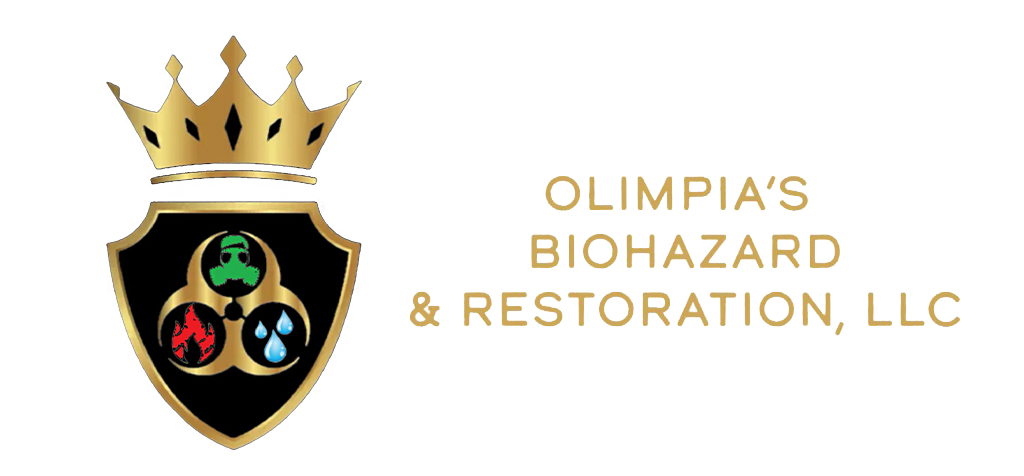Hey there, Portland residents! Living in the Pacific Northwest, we know how beautiful our city is, but we also understand the constant battle against moisture. Sometimes, it’s not easy to spot water damage until it becomes a significant issue. In this guide, Olimpia’s Biohazard and Restoration will discuss signs that may indicate you need water remediation services in Portland. From mysterious musty odors to those unexplained water stains on your ceiling or walls, these subtle hints could be warning signs of hidden water damage. So, let’s explore these red flags and learn when it’s time to call in the professionals to protect your Portland home from potential water-related headaches.
Water remediation services in Portlan:
Here are some common signs that may indicate the need for water remediation services in Portland:
Damp or Moldy Odors:


Damp or moldy odors refer to musty or earthy smells that are often associated with the presence of excess moisture or mold growth in a building or specific area. These odors can be quite distinct and are usually noticeable when you enter a space or when the ventilation is poor.
When there is excessive moisture in an environment, such as from water leaks, high humidity, or inadequate drying after a water-related incident, it creates a favorable environment for mold and mildew to thrive. Mold spores are naturally present in the air, and when they encounter moisture, they can start growing and spreading on various surfaces.
As mold grows and multiplies, it releases volatile organic compounds (VOCs) that contribute to the characteristic damp or moldy odor. These odors can be quite pungent and persistent, even if the mold growth is not readily visible. In some cases, the odor may be stronger in enclosed spaces like basements, attics, or areas with poor ventilation.
Damp or moldy odors should be taken seriously as they can indicate hidden water damage and potential health risks. Mold spores and the associated VOCs can cause allergic reactions, respiratory issues, and worsen existing respiratory conditions, especially for individuals with sensitivities or compromised immune systems.
If you notice damp or moldy odors in your home or building, it’s essential to investigate the source of the moisture and address it promptly. Seeking professional water remediation services can help identify and mitigate the underlying water damage, remove mold growth, and restore the indoor environment to a safe and healthy state.
Visible Mold or Mildew:
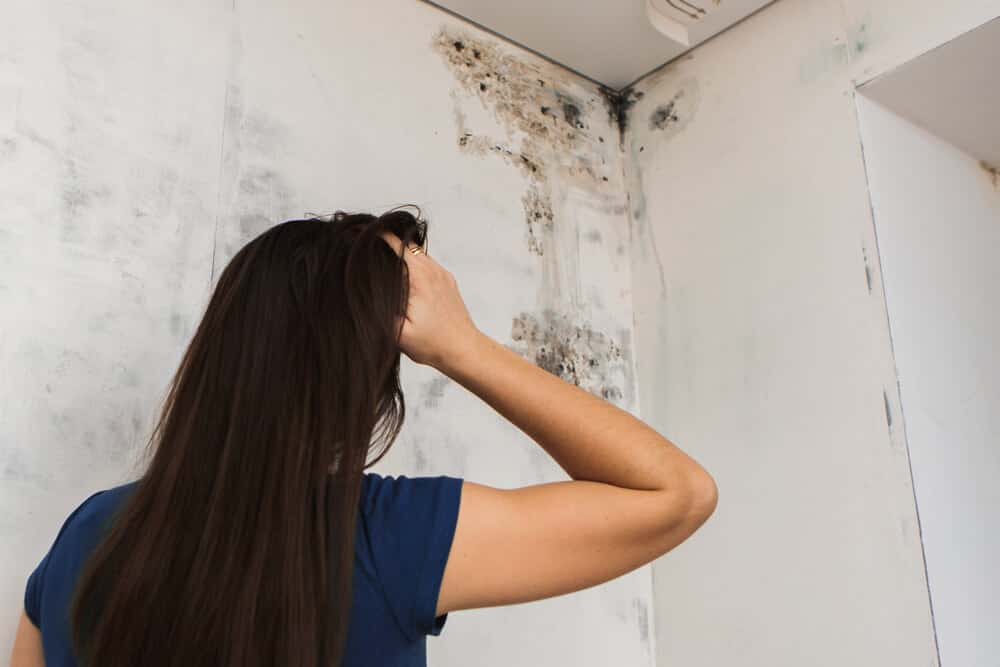

Visible mold or mildew refers to the presence of fungal growth that can be seen with the naked eye on surfaces such as walls, ceilings, floors, or other areas within a building. Mold and mildew are types of fungi that thrive in damp, humid environments and can often indicate underlying water damage.
When there is excessive moisture or water intrusion, it creates an ideal environment for mold spores to settle and grow. Mold can appear in various colors, including black, green, brown, or even white. It can take on different textures, appearing fuzzy, powdery, or slimy depending on the type of mold and the materials it is growing on.
Visible mold growth is a clear indication that there is an ongoing moisture issue. It can occur in areas with high humidity, water leaks, condensation, or inadequate ventilation. Common areas where mold may be visible include bathrooms, basements, kitchens, or any other spaces prone to moisture accumulation.
It is important to address visible mold growth promptly, as mold can cause structural damage to building materials and pose health risks. Exposure to mold spores can trigger allergic reactions, respiratory issues, and irritate the eyes, nose, and throat.
When encountering visible mold or mildew, it is advisable to seek professional assistance from water remediation experts who can assess the extent of the mold growth, identify the source of moisture, and safely remove the mold. They can also provide recommendations for remediation and steps to prevent future mold growth.
Please note that disturbing visible mold growth without proper precautions can release mold spores into the air, potentially exacerbating the problem. Therefore, it is best to rely on professionals experienced in handling mold remediation.
Water Stains or Discoloration:
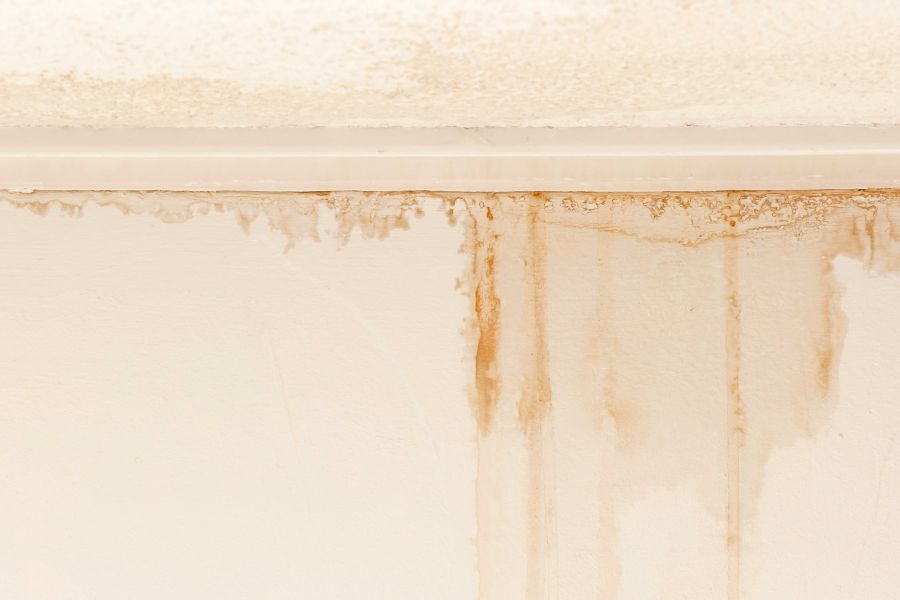

Water stains or discoloration refer to noticeable marks or changes in the color of surfaces such as walls, ceilings, floors, or other areas caused by water intrusion or leaks. These stains can vary in appearance, ranging from yellowish or brownish discoloration to darker patches, depending on the severity and duration of the water exposure.
When water infiltrates building materials, it can leave behind visible marks or discoloration as it seeps into the porous surfaces. The staining occurs as the water carries dirt, minerals, or other substances and leaves them behind when it evaporates or dries up.
Water stains can be indicative of various issues, including plumbing leaks, roof leaks, faulty seals around windows or doors, or even issues with the building’s foundation. They are often found near areas where water is likely to accumulate or flow, such as under sinks, around windows, along ceilings, or at the base of walls.
It’s important to note that while water stains themselves may not pose an immediate threat, they are a visible sign of water damage and can lead to more significant problems if left unaddressed. Water-damaged surfaces can weaken, mold can grow behind the visible staining, and structural integrity may be compromised.
Absolutely, investigating the source of water stains or discoloration is crucial, and quick response is key when it comes to water damage restoration. When you notice these signs, it’s advisable to seek assistance from water remediation professionals promptly. Their expertise can help identify the source of the water intrusion, address it effectively, repair the affected areas, and prevent further damage.
Taking water stains or discoloration seriously is vital, as they often indicate ongoing water damage that requires immediate attention to maintain the integrity and safety of your home or building. Acting swiftly can make a significant difference in preventing more extensive and costly issues down the road.
Warped or Buckling Floors:
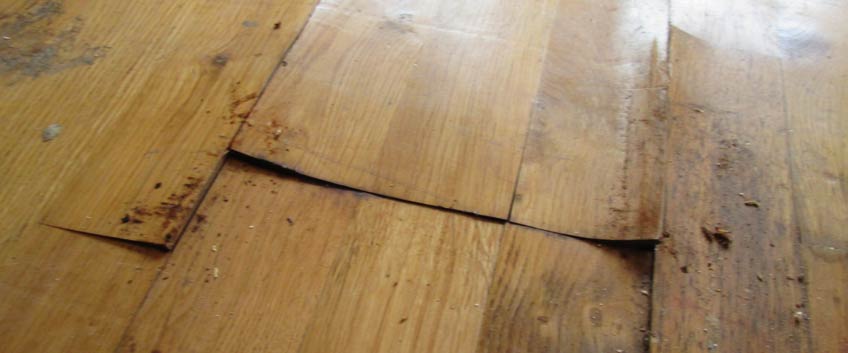

Warped or buckling floors refer to flooring surfaces that have become uneven, bowed, or distorted, often due to water damage or excessive moisture. This issue is commonly observed in areas where water has penetrated the flooring materials, causing them to swell or warp.
When moisture infiltrates floors, it can affect various types of flooring, including hardwood, laminate, vinyl, or even carpeting. The excessive moisture causes the flooring materials to absorb water, leading to expansion and changes in shape. Over time, this can result in visible warping, buckling, or lifting of the flooring surface.
Warped or buckling floors are typically a sign of underlying water damage. Common causes include plumbing leaks, flooding, high humidity, or inadequate moisture protection in areas prone to water exposure, such as bathrooms, kitchens, basements, or areas near windows or exterior doors.
It’s important to address warped or buckling floors promptly as they can pose safety hazards and may indicate ongoing water intrusion. Warped floors can become uneven, leading to tripping hazards, and compromised structural integrity. Moreover, if left untreated, the excess moisture can promote mold growth and further damage the flooring materials.
Certainly, when faced with warped or buckling floors, it’s essential to consider the services of professional water remediation experts. These professionals can assess the full extent of the damage, pinpoint and address the underlying water issue, and offer tailored solutions for repairing or replacing the affected flooring materials.
Understanding that addressing the source of water damage and restoring the flooring is critical not only helps prevent further structural damage but also maintains a safe and functional living environment. It’s a proactive approach that can save you money in the long run by preventing more extensive and costly repairs down the line.
Sudden Spike in Water Bill:


A sudden spike in water bill refers to a significant and unexpected increase in the amount of money you’re being charged for your water usage. If you notice a sudden and unexplained rise in your water bill, it could be an indication of a hidden water leak or excessive water usage within your property.
Here are a few possible causes for a sudden spike in your water bill:
Undetected Water Leak: Even small, unnoticed leaks in your plumbing system can result in continuous water flow, leading to increased water consumption and a higher bill. These leaks can occur in pipes, faucets, toilets, or irrigation systems.
Malfunctioning or Running Toilet: A faulty toilet that keeps running or has a flapper that doesn’t seal properly can waste a significant amount of water over time. This continuous flow of water can contribute to an elevated water bill.
Outdoor Watering or Irrigation Issues: If you have an automated irrigation system or regularly water your lawn, malfunctioning sprinklers or valves can cause water to be wasted or used excessively, resulting in higher water bills.
Changes in Water Usage Patterns: If there have been recent changes in your household or property, such as guests staying over, increased laundry or dishwashing, or filling up swimming pools, it could lead to higher water usage and subsequently a higher bill.
Faulty Water Meter: In rare cases, a faulty or malfunctioning water meter can incorrectly measure your water usage, leading to inaccurate billing and sudden spikes in your water bill.
If you experience a sudden spike in your water bill, it’s essential to investigate the cause. Start by checking for any visible leaks in your plumbing fixtures, toilets, or irrigation systems. Monitor your water meter to see if there is continuous water usage when all water sources are turned off.
If you cannot identify the cause of the increased water usage or suspect a hidden leak, it is advisable to contact a professional plumber or water remediation service. They can conduct a thorough inspection, identify the source of the problem, and make the necessary repairs to prevent further water waste and restore normal water usage.
Addressing the issue promptly not only helps you avoid unnecessary expenses but also conserves water resources and prevents potential damage to your property from ongoing water leaks
Water Puddles or Standing Water:
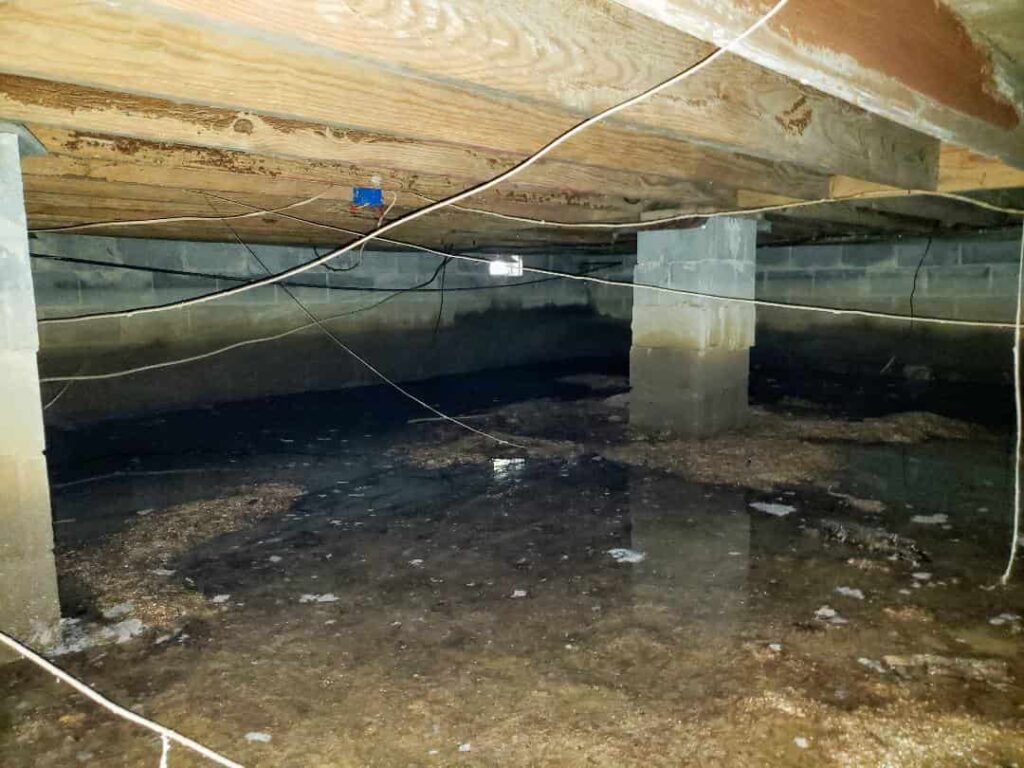

Water puddles or standing water refer to accumulations of water that remain stagnant in specific areas of your property. These puddles can form both indoors and outdoors and are often a sign of water intrusion or inadequate drainage.
Here are a few reasons why you might notice water puddles or standing water:
Plumbing Leaks: Water puddles indoors may indicate plumbing leaks in pipes, fixtures, or appliances. Leaky pipes or faulty plumbing connections can result in water pooling on floors, under sinks, or near appliances like washing machines or dishwashers.
Roof Leaks: If you observe water puddles or staining on your ceiling or upper walls, it could be a sign of a roof leak. Roof leaks can allow water to enter your home, leading to puddles forming on the floor or seeping into walls.
Poor Drainage: In outdoor areas, inadequate drainage systems or clogged gutters can cause water to accumulate. This can lead to puddles forming in your yard, driveway, patio, or basement.
Foundation Issues: Water puddles near the foundation of your home could indicate problems with your foundation’s drainage. If water is not effectively diverted away from the foundation, it can pool around the base of the building.
Flooding or Weather Events: Heavy rain, storms, or flooding can result in water pooling in low-lying areas or poorly drained regions of your property.
Water puddles or standing water should not be ignored, as they can lead to various issues such as structural damage, mold growth, or compromised indoor air quality. Additionally, standing water outdoors can create safety hazards and attract pests.
If you notice water puddles or standing water, it’s crucial to identify the source and take appropriate action. This may involve fixing plumbing leaks, addressing roof issues, improving drainage systems, or seeking professional help for foundation or basement waterproofing.
By addressing the underlying causes of water accumulation, you can prevent further damage, promote a safe environment, and maintain the integrity of your property.
Peeling or Blistering Paint:
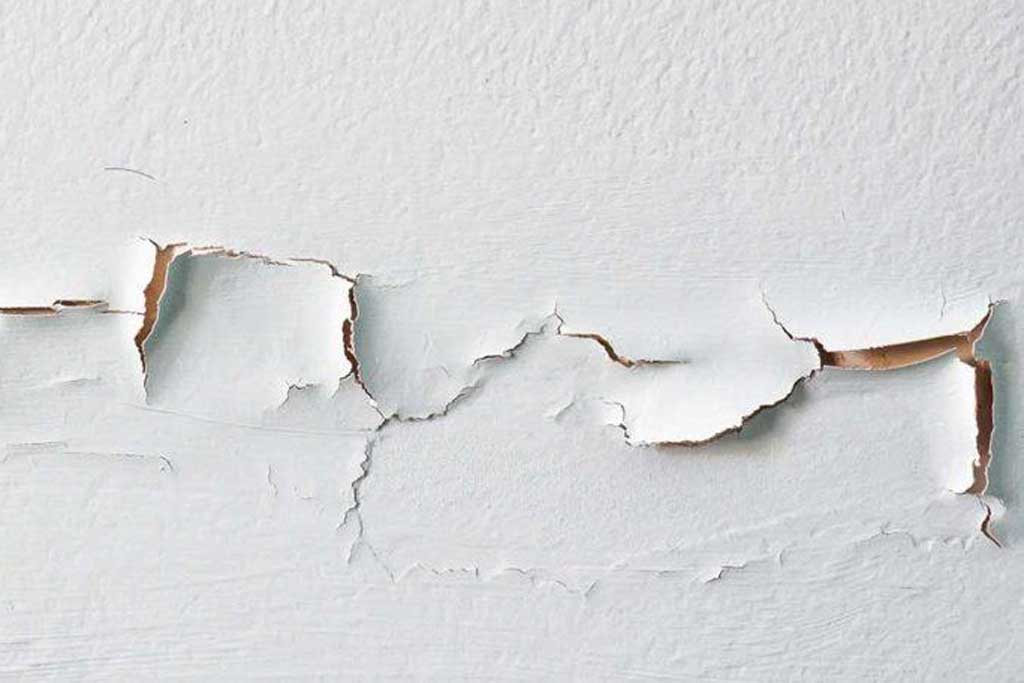

Peeling or blistering paint refers to the detachment or bubbling of paint layers from surfaces, resulting in a visibly uneven or damaged appearance. This issue is often caused by moisture infiltration, which can compromise the adhesion between the paint and the underlying surface.
Here are a few reasons why you may observe peeling or blistering paint:
Moisture Damage: Excess moisture, whether from leaks, condensation, or high humidity levels, can seep into the walls or surfaces. Over time, this moisture can weaken the bond between the paint and the substrate, leading to peeling or blistering.
Water Leaks: Plumbing leaks, roof leaks, or inadequate waterproofing can introduce water into the walls or ceilings, causing the paint to lose its adhesion. The trapped moisture behind the paint film can create blisters or bubbles, leading to peeling.
Moisture Vapor Transmission: Certain surfaces, such as concrete or masonry, can allow moisture vapor to pass through them. If the paint applied on such surfaces does not have proper vapor barrier properties, moisture can accumulate between the paint and the substrate, resulting in peeling or blistering.
Poor Surface Preparation: Insufficient surface preparation, such as inadequate cleaning, removal of old paint, or failure to prime properly, can prevent the paint from adhering securely. This can lead to premature peeling or blistering.
Incompatible Paint Layers: Applying incompatible paint layers, such as applying an oil-based paint over a water-based paint without proper preparation, can cause adhesion issues and result in peeling or blistering.
Peeling or blistering paint not only affects the aesthetics of your property but can also expose underlying surfaces to potential damage. It’s important to address this issue to prevent further deterioration and to maintain a visually appealing and protected environment.
To resolve peeling or blistering paint, it is recommended to address the source of moisture, repair any leaks, and improve ventilation or insulation to minimize moisture-related issues. Additionally, removing loose or damaged paint, properly preparing the surface, and applying a suitable primer and paint system can help ensure a long-lasting and durable finish.
If the peeling or blistering paint issue is extensive or you’re unsure of the underlying causes, it may be beneficial to consult professional painters or water remediation specialists who can assess the situation and provide appropriate solutions for repairing and repainting the affected areas.
Sudden Increase in Allergy or Respiratory Symptoms:


A sudden increase in allergy or respiratory symptoms refers to the onset or worsening of symptoms such as coughing, sneezing, wheezing, congestion, or difficulty breathing. If these symptoms occur abruptly and persistently, it could be a result of exposure to allergens or irritants, including those associated with water damage and mold growth.
Here’s how water damage and mold can contribute to allergy or respiratory symptoms:
Mold Spores: Water damage, whether from leaks, flooding, or excessive moisture, creates an ideal environment for mold growth. Mold releases tiny spores into the air, which can trigger allergic reactions in sensitive individuals. Inhaling or coming into contact with these spores can lead to respiratory symptoms such as sneezing, coughing, and congestion.
Allergens and Irritants: Water damage can also introduce other allergens and irritants into your living environment. Dust mites, bacteria, and fungi thrive in moist conditions, exacerbating allergy symptoms. Additionally, water damage can release chemicals from building materials, such as volatile organic compounds (VOCs), which can irritate the respiratory system and cause discomfort.
Dampness-Related Asthma: Prolonged exposure to damp or moldy environments can contribute to the development or worsening of asthma symptoms. The presence of mold and dampness can trigger asthma attacks, increase respiratory inflammation, and lead to breathing difficulties.
If you experience a sudden increase in allergy or respiratory symptoms, it’s important to consider the possibility of water damage or mold growth in your surroundings. Take note of any recent water incidents, leaks, or visible signs of moisture, as they may be contributing factors.
To address the issue, it’s advisable to:
Reduce Exposure: Limit exposure to the affected areas and avoid contact with visible mold or areas with water damage until proper remediation can take place.
Seek Medical Advice: Consult a healthcare professional to assess your symptoms and determine the appropriate course of action. They may recommend allergy testing or prescribe medications to alleviate your symptoms.
Address Water and Mold Issues: Engage the services of water remediation and mold specialists who can identify and address the underlying water damage and mold growth. They will conduct thorough inspections, remediate affected areas, and provide recommendations to prevent future occurrences.
By addressing water damage and mold issues, you can help improve indoor air quality, reduce allergen exposure, and alleviate allergy or respiratory symptoms
Deteriorating or Sagging Drywall:
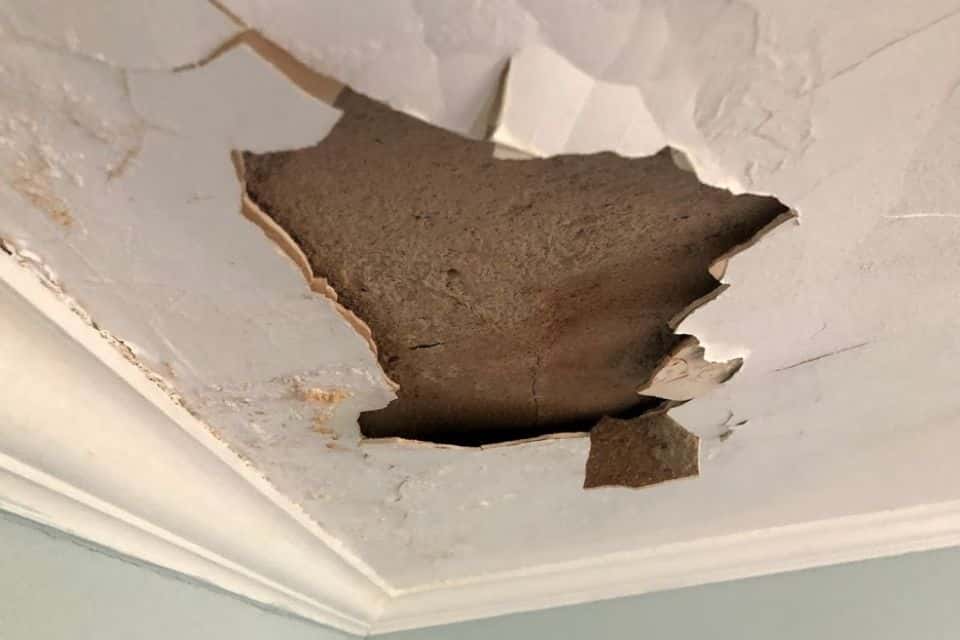

Deteriorating or sagging drywall refers to the condition where the gypsum-based material used to construct walls and ceilings shows signs of damage, weakening, or sagging. This issue can be a result of water damage, excessive moisture, or underlying structural problems.
Here are a few reasons why you might observe deteriorating or sagging drywall:
Water Damage: Water intrusion from leaks, plumbing issues, or flooding can saturate drywall, causing it to soften, weaken, and eventually deteriorate. Over time, this can lead to sagging, bulging, or crumbling of the drywall.
High Humidity or Condensation: Persistent high humidity levels or condensation buildup within a space can gradually affect the integrity of drywall. The constant exposure to moisture can cause the gypsum material to break down, resulting in deterioration and sagging.
Roof Leaks: Roof leaks can allow water to seep into the walls or ceilings, leading to water damage and compromising the structural integrity of the drywall. As a result, the affected drywall may exhibit signs of deterioration or sagging.
Foundation Issues: Problems with the building’s foundation, such as settling or shifting, can cause stress on the drywall. This can lead to cracks, separation from the underlying structure, and eventual sagging or deterioration.
Inadequate Installation: Improper installation techniques or the use of substandard materials can contribute to the premature deterioration of drywall. If the drywall is not securely fastened or lacks proper joint compound and tape application, it can lead to sagging or weakening over time.
Deteriorating or sagging drywall not only compromises the aesthetic appearance of your property but can also be an indication of underlying structural problems or ongoing moisture issues. It is crucial to address this issue promptly to prevent further damage and maintain a safe environment.
To address deteriorating or sagging drywall, it is recommended to:
Identify the Source of Moisture: Determine and resolve the underlying cause of water intrusion or excessive moisture. This may involve fixing leaks, improving ventilation, or addressing drainage issues.
Replace Damaged Drywall: If the drywall has significantly deteriorated or sagged, it may need to be replaced. Engage the services of a professional contractor or drywall specialist to assess the extent of the damage and carry out proper replacement or repair.
Address Structural Issues: If the deterioration or sagging is due to foundation problems or structural issues, consult with a structural engineer or a qualified professional to evaluate and provide appropriate solutions.
By addressing the root causes of deteriorating or sagging drywall, you can restore the integrity of your walls and ceilings, enhance the visual appeal of your property, and ensure the long-term stability and safety of your living environment.
FAQS
How do you know if you have water damage behind a wall?
Signs of water damage behind a wall include visible stains, discoloration, bulging or peeling paint, musty odors, mold growth, dampness, or a soft or spongy feel when pressing on the wall.
Why do we need water damage restoration services?
Water damage restoration services are essential to mitigate the effects of water damage, prevent further structural damage, mold growth, and health hazards, and restore the affected property to its pre-damaged condition.
What is water restoration?
Water restoration refers to the process of mitigating and restoring areas affected by water damage. It involves removing excess water, drying and dehumidifying the space, cleaning and sanitizing, and repairing or replacing damaged materials.
What is the remediation process of water?
The water remediation process involves identifying and resolving the source of water intrusion, extracting standing water, drying and dehumidifying the affected areas, sanitizing surfaces, and repairing or replacing damaged materials to restore a safe and dry environment.
What are the three types of remediation?
The three types of remediation commonly used in the context of water damage are water remediation (addressing water-related issues), mold remediation (removing and preventing mold growth), and structural remediation (repairing and restoring damaged structures).
How can we restore water quality?
To restore water quality, it typically involves water treatment processes such as filtration, disinfection, and chemical treatment to remove contaminants, improve taste, odor, and clarity, and ensure the water meets safety standards for consumption or specific uses.
Conclusion
Water damage can have significant consequences for both the structural integrity of a property and the health and well-being of its occupants. Signs such as damp or moldy odors, visible mold or mildew, water stains or discoloration, warped floors, sudden spikes in water bills, water puddles or standing water, peeling or blistering paint, and deteriorating or sagging drywall should not be ignored. Prompt action is crucial to mitigate the damage and restore the affected areas. Seeking professional water remediation services can help identify the source of the problem, address water-related issues, ensure proper restoration, and create a safe and habitable environment. By taking swift and effective measures, you can minimize the impact of water damage and protect your property and well-being.
